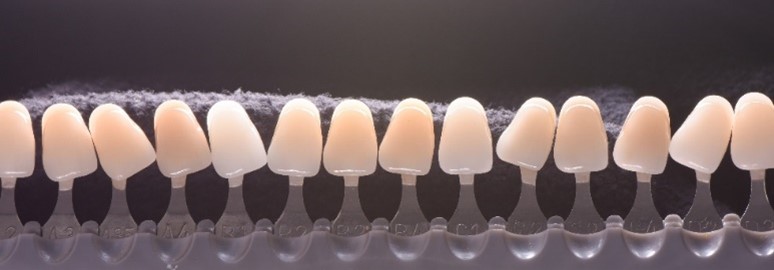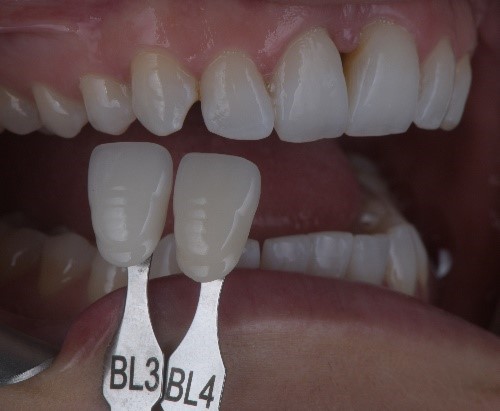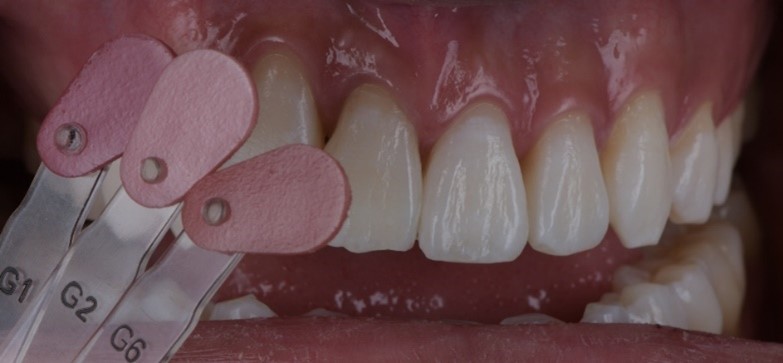Basics
There are three components of colour when colour matching your tooth; value, chroma and hue. The most important is value, also known as the brightness, this is because our eye detects value differences first. The second most important is chroma, also known as the saturation of the colour, for example soft red vs strong red. Finally, the third component is hue, and this is known as the colour temperature. Other components that need to be considered is fluorescence, opalescence and effects. Examples of effects are white spots, texture and degree of smoothness.
Veneers Colour Chart

What is the veneers colour chart?
There are plenty of brands of colour charts to use when shade matching your veneers. However, the major brand is Vita, this is used worldwide amongst dentists.

How to choose colour of veneers
This is personal choice based on your dentist’s opinion and yours. The main thing to consider is your preferences alongside your skin tone, complexion and style of make-up. The colour of temporary veneers and your original teeth will give you a great guide as to where to head to. Remember, using other people’s teeth/celebrity teeth is not advisable due to the difference in hair, skin, eye colour and make up.

How do I know if my veneers match my teeth colour?
Look at them in different settings, natural light is best gauge as this is what lighting you have around majority of the time. Also work with indoor lighting also in offices and homes. Using nightclub lighting is not advisable due to presence of ultraviolet.

Choosing the right colour
When choosing, there are numerous factors affecting the colour of your veneers. These are:
-The number of veneers involved
– Your skin tone, make-up tone
– Existing tooth shade (the tooth which is having the veneer placed)
– Cement colour (your dentist will confirm this with you)
– Ceramic/porcelain thickness (again, your dentist will confirm this with you)

Common Questions Answered:
Do cosmetic dentists choose the colour?
The decision is made between both you and your dentist. Its important to consider the dentist recommendations based on their expertise and knowledge, but you are the predominant decision maker.
What colour should teeth naturally be?
Natural teeth usually fall into the A1 – A3.5 colour on the shade guide. However, once teeth are whitened, they can be closer to B1, with some even going brighter to BL4 and BL3.
What is the most common colour for veneers?
The most common colour that patients and dentists choose for veneers is BL3 or BL4
What is the best colour for veneers?
In our dentists’ professional opinion, its usually BL3/4, sometimes called BL3.5
Is there a shade that is too white?
BL0/1/2 do not exist in reality and if natural is what you’re looking for, these shades would appear very white. However, for some people who take part in reality TV shows such as Love Island or TOWIE or Real Housewives of Cheshire or are on camera for their work, BL1/BL2 can be an appropriate choice.
What to do if your veneers are too white?
Have them changed with a cosmetic dentist London that is experienced in dealing with cosmetic cases, such as Dr Sahil Patel at Marylebone Smile Clinic.
Which colour veneer is the whitest?
The whitest shade available for a veneer is a modified BL1, sometimes called BL0.
What is fluorescence in simple terms?
Fluorescence is when light hits a tooth and bounces internally off itself to then shine back forwards as visible light.
To human eyes, this shows a tooth to be ‘real’ or showing health, as man-made materials to not typically have this effect. Naturally occurring material.
Why do white spots occur?
White spots can occur for many reasons, but normally is it due to fluorosis, which is when the teeth are overexposed to fluoride. Other reasons could be a lack of calcium in your diet, demineralization of the enamel on your tooth or enamel hypoplasia. Enamel hypoplasia is caused from the lack of development of enamel, this happens at a very young age.
Want to know more?
Get in touch to enquire about our services or to book an appointment.


